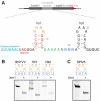Investigating the correlation between Xrn1-resistant RNAs and frameshifter pseudoknots
- PMID: 37400999
- PMCID: PMC10321173
- DOI: 10.1080/15476286.2023.2205224
Investigating the correlation between Xrn1-resistant RNAs and frameshifter pseudoknots
Abstract
Xrn1-resistant RNA structures are multifunctional elements employed by an increasing number of RNA viruses. One of such elements is the coremin motif, discovered in plant virus RNAs, of which the structure has been hypothesized to form a yet unelucidated pseudoknot. Recently, the coremin motif was shown to be capable of stalling not only Xrn1, but scanning ribosomes as well. Following that observation, in this study we demonstrate that the coremin motif can promote -1 ribosomal frameshifting, similar to better-characterized viral frameshifting pseudoknots. Since this function was lost in concert with substitutions that were known to disturb Xrn1-resistance, we developed a frameshifting screen for finding novel Xrn1-resistant RNAs by randomizing parts of the coremin motif. This yielded new insights into the coremin motif structure, as Xrn1-resistant variations were identified that more clearly indicate a pseudoknot interaction. In addition, we show that the Xrn1-resistant RNA of Zika virus promotes frameshifting as well, while known -1 programmed ribosomal frameshifting pseudoknots do not stall Xrn1, suggesting that promoting frameshifting is a universal characteristic of Xrn1-resistant RNAs, but that Xrn1-resistance requires more than just a frameshifting pseudoknot.
Keywords: RNA pseudoknot; Xrn1; Zika virus; coremin motif; ribosomal frameshifting.
Conflict of interest statement
No potential conflict of interest was reported by the authors.
Figures





References
MeSH terms
Substances
LinkOut - more resources
Full Text Sources
Other Literature Sources
Medical
